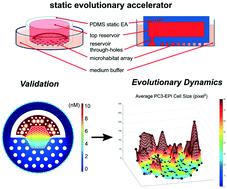Our official English website, www.x-mol.net, welcomes your
feedback! (Note: you will need to create a separate account there.)
An in vitro tumor swamp model of heterogeneous cellular and chemotherapeutic landscapes.
Lab on a Chip ( IF 6.1 ) Pub Date : 2020-06-18 , DOI: 10.1039/d0lc00131g Ke-Chih Lin 1 , Yusha Sun , Gonzalo Torga , Pema Sherpa , Yihua Zhao , Junle Qu , Sarah R Amend , Kenneth J Pienta , James C Sturm , Robert H Austin
Lab on a Chip ( IF 6.1 ) Pub Date : 2020-06-18 , DOI: 10.1039/d0lc00131g Ke-Chih Lin 1 , Yusha Sun , Gonzalo Torga , Pema Sherpa , Yihua Zhao , Junle Qu , Sarah R Amend , Kenneth J Pienta , James C Sturm , Robert H Austin
Affiliation

|
The heterogenous, highly metabolic stressed, poorly irrigated, solid tumor microenvironment – the tumor swamp – is widely recognized to play an important role in cancer progression as well as the development of therapeutic resistance. It is thus important to create realistic in vitro models within the therapeutic pipeline that can recapitulate the fundamental stress features of the tumor swamp. Here we describe a microfluidic system which generates a chemical gradient within connected microenvironments achieved through a static diffusion mechanism rather than active pumping. We show that the gradient can be stably maintained for over a week. Due to the accessibility and simplicity of the experimental platform, the system allows for not only well-controlled continuous studies of the interactions among various cell types at single-cell resolution, but also parallel experimentation for time-resolved downstream cellular assays on the time scale of weeks. This approach enables simple, compact implementation and is compatible with existing 6-well imaging technology for simultaneous experiments. As a proof-of-concept, we report the co-culture of a human bone marrow stromal cell line and a bone-metastatic prostate cancer cell line using the presented device, revealing on the same chip a transition in cancer cell survival as a function of drug concentration on the population level while exhibiting an enrichment of poly-aneuploid cancer cells (PACCs) as an evolutionary consequence of high stress. The device allows for the quantitative study of cancer cell dynamics on a stress landscape by real-time monitoring of various cell types with considerable experimental throughput.
中文翻译:

异质细胞和化学治疗景观的体外肿瘤沼泽模型。
广泛公认的异质性,高代谢压力,灌溉不良,实体肿瘤微环境-肿瘤沼泽-在癌症进展以及治疗耐药性的发展中起着重要作用。因此,重要的是要创造出逼真的体外治疗管道中的模型可以概括肿瘤沼泽的基本应激特征。在这里,我们描述了一种微流体系统,该系统通过静态扩散机制而不是主动泵送在连接的微环境中产生化学梯度。我们表明,梯度可以稳定地维持一周以上。由于实验平台的可访问性和简单性,该系统不仅允许在单细胞分辨率下对各种细胞类型之间的相互作用进行良好控制的连续研究,而且还可以在时间范围内对时间分辨的下游细胞测定进行并行实验个星期。这种方法实现了简单,紧凑的实现,并且与用于同步实验的现有6孔成像技术兼容。作为概念证明,我们报告了使用提出的装置共同培养人类骨髓基质细胞系和骨转移性前列腺癌细胞系,在同一芯片上揭示了癌细胞存活率随人群中药物浓度的变化而变化。表现出高应力进化结果的聚非整倍体癌细胞(PACC)的富集。该设备可通过实时监控各种细胞类型并以可观的实验通量来定量研究应激环境下的癌细胞动力学。在同一芯片上揭示了癌细胞存活率随人口水平上的药物浓度而变化的过程,同时展示了由于高压力而导致的多异倍体癌细胞(PACC)的富集。该设备可通过实时监控各种细胞类型并以可观的实验通量来定量研究应激环境下的癌细胞动力学。在同一芯片上揭示了癌细胞存活率随人口水平上的药物浓度而变化的过程,同时展示了多聚异倍体癌细胞(PACC)的富集是高胁迫进化的结果。该设备可通过实时监控各种细胞类型并以可观的实验通量来定量研究应激环境下的癌细胞动力学。
更新日期:2020-07-14
中文翻译:

异质细胞和化学治疗景观的体外肿瘤沼泽模型。
广泛公认的异质性,高代谢压力,灌溉不良,实体肿瘤微环境-肿瘤沼泽-在癌症进展以及治疗耐药性的发展中起着重要作用。因此,重要的是要创造出逼真的体外治疗管道中的模型可以概括肿瘤沼泽的基本应激特征。在这里,我们描述了一种微流体系统,该系统通过静态扩散机制而不是主动泵送在连接的微环境中产生化学梯度。我们表明,梯度可以稳定地维持一周以上。由于实验平台的可访问性和简单性,该系统不仅允许在单细胞分辨率下对各种细胞类型之间的相互作用进行良好控制的连续研究,而且还可以在时间范围内对时间分辨的下游细胞测定进行并行实验个星期。这种方法实现了简单,紧凑的实现,并且与用于同步实验的现有6孔成像技术兼容。作为概念证明,我们报告了使用提出的装置共同培养人类骨髓基质细胞系和骨转移性前列腺癌细胞系,在同一芯片上揭示了癌细胞存活率随人群中药物浓度的变化而变化。表现出高应力进化结果的聚非整倍体癌细胞(PACC)的富集。该设备可通过实时监控各种细胞类型并以可观的实验通量来定量研究应激环境下的癌细胞动力学。在同一芯片上揭示了癌细胞存活率随人口水平上的药物浓度而变化的过程,同时展示了由于高压力而导致的多异倍体癌细胞(PACC)的富集。该设备可通过实时监控各种细胞类型并以可观的实验通量来定量研究应激环境下的癌细胞动力学。在同一芯片上揭示了癌细胞存活率随人口水平上的药物浓度而变化的过程,同时展示了多聚异倍体癌细胞(PACC)的富集是高胁迫进化的结果。该设备可通过实时监控各种细胞类型并以可观的实验通量来定量研究应激环境下的癌细胞动力学。











































 京公网安备 11010802027423号
京公网安备 11010802027423号